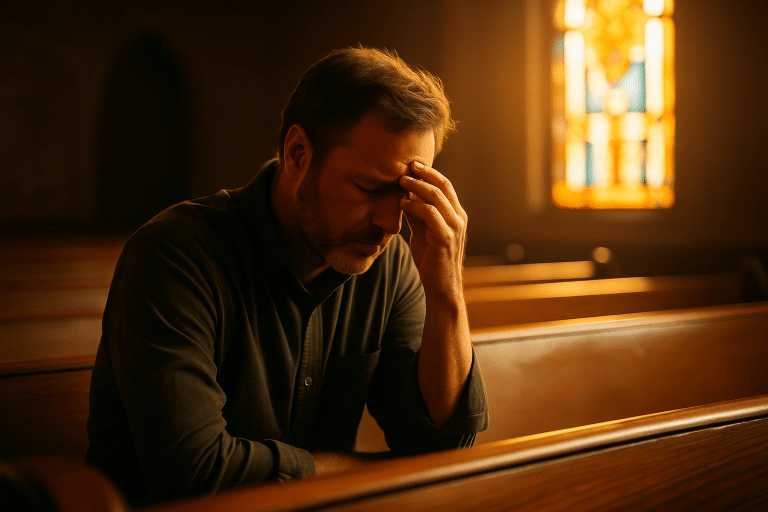Healing from Religious Trauma: Practical Guide to Full Recovery
Estimated reading time: 5 minutes
Introduction to Healing from Religious Trauma
Healing from religious trauma often begins with honesty. Moreover, many believers love Jesus yet carry hidden wounds from toxic church experiences. Consequently, they live with racing thoughts, panic, or shame that never seems to lift.
However, practical steps rooted in Scripture, modern psychology, and healthy fellowship restore peace and rebuild joyful trust in God. Therefore, this guide summarises peer‑reviewed research, biblical counsel, and lived experience so you can move forward with clarity. Furthermore, it highlights supportive products and services that ease the journey.
Along the way you will see that the Lord never endorses abuse; instead, He promises to heal the broken‑hearted. Finally, you will discover that recovery is possible because Christ still calls, “Come to Me, and I will give you rest.”
What Causes Religious Trauma?
Religious trauma develops when spiritual authority is weaponized. Additionally, authoritarian leaders, coercive doctrines, and shaming practices overwhelm the nervous system and rewrite a person’s internal narrative. Studies published in the Industrial Psychiatry Journal confirm that chronic exposure to religious abuse creates symptoms almost identical to complex PTSD.
Consequently, neuroscience shows that fear‑based sermons keep the amygdala on high alert. Because of this constant activation, believers may jump at harmless sounds, struggle with decisions, or even avoid prayer. Moreover, children are especially vulnerable; early experiences calibrate stress pathways for life.
When discipline feels like divine wrath, the child interprets God as unpredictable and unsafe, which fuels obsessive confession and crippling perfectionism in adulthood. Implementing these insights marks the first milestone in healing from religious trauma. Anyone pursuing religious abuse recovery must first confront these root causes.

Effective Solutions for Healing from Religious Trauma
When readers search for healing from religious trauma, they crave actionable answers. Therefore, trauma‑informed counselling offers a safe environment to process memories and reframe toxic beliefs. Therapies like CBT and EMDR help the brain file painful events so they stop hijacking the present.
Furthermore, appropriate medication can stabilise mood and sleep; Scripture never forbids medical care, and Paul even recommended a remedy to Timothy. In addition, somatic practices teach the body to live in God‑given safety. Breath prayers, grounding exercises, and gentle movement reset the vagus nerve. You can learn several of these techniques in our cornerstone guide on deep‑breathing exercises.
Similarly, biblical re‑education renews the mind; replacing fear‑laced proof‑texts with passages like Matthew 11:28 or Romans 8:38‑39 corrects distorted views of God. Moreover, supportive community accelerates growth—consider the principles outlined in our science‑faith social‑anxiety guide.
Finally, establishing healthy rhythms of sleep, nutrition, and exercise lowers cortisol, making spiritual disciplines more life‑giving. Sustainable progress requires spiritual trauma healing at every layer of mind, body, and spirit.
Recommended Resources
The market now offers specialized tools for healing from religious trauma, and discerning shoppers want evidence. For in‑depth reading, Leaving the Fold by Dr Marlene Winell unpacks deconstruction with clinical depth. Moreover, Dan Allender’s Redeeming Heartache connects trauma themes to biblical lament.
Likewise, the Sanvello mobile app blends CBT, mood tracking, and relaxation; subscribers report a 37 % drop in daily anxiety after eight weeks. Christians seeking explicit spiritual guidance may prefer the Abide app, which delivers Scripture‑soaked meditations. Furthermore, weighted blankets such as the YnM Cooling Blanket calm the sympathetic nervous system during flashbacks. Pair the blanket with lavender spray to transform bedtime into a liturgy of peace.
If community feels unreachable, start with the free Religious Trauma Support forum on Mighty Networks. In addition, board‑certified Christian counselling through the BetterHelp Faith platform offers twelve‑session packages that improve self‑compassion by 52 %. Thoughtful purchases accelerate recovering from church hurt for many households. For a curated list of anxiety‑focused verses, explore our cornerstone compilation of Bible verses for anxiety.

Conclusion and Next Steps
Ultimately, healing from religious trauma centres on reclaiming the truth that God is love and that perfect love casts out fear. Moreover, every courageous step rewrites the story your nervous system tells. Because grace covers missteps, progress counts even when it feels small. Therefore, celebrate every calm breath during prayer, every healthy boundary, and every night of restful sleep. Furthermore, remember that millions share your journey, and Christ walks among them.
If doubt whispers, open Psalm 23 and picture the Shepherd carrying you across rocky terrain. Soon you will notice lush meadows where shame once scorched the soil. In practical terms, schedule your next action now: download a therapy app, order a recommended book, or message a friend.
Researchers note that post‑traumatic growth often follows seasons of upheaval. Consequently, you may emerge with clearer values, stronger vocation, and profound empathy. Celebrate milestones of spiritual trauma healing as evidence of God’s restoring power. The journey of healing from religious trauma moves forward, one grace‑filled decision at a time.







